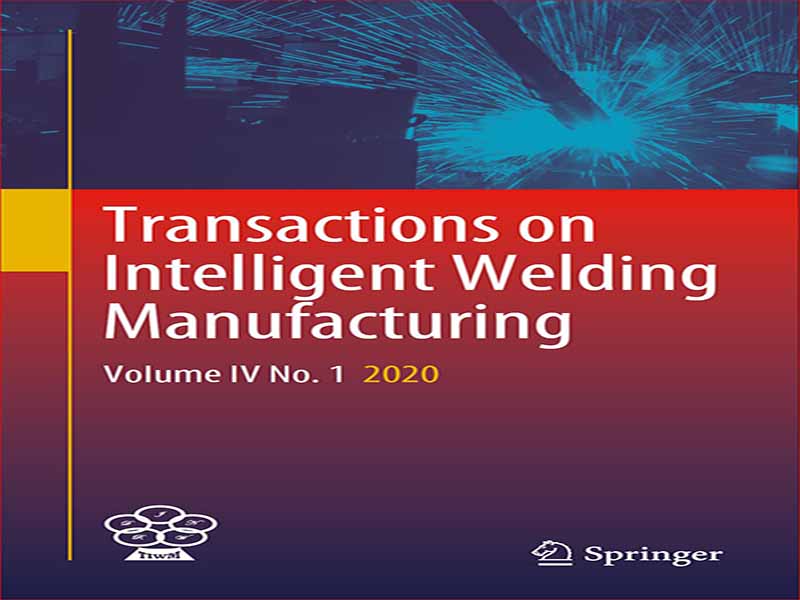- عنوان کتاب: Transactions on Intelligent Welding Manufacturing
- نویسنده: Shanben Chen
- حوزه: جوشکاری
- سال انتشار: 2022
- تعداد صفحه: 102
- زبان اصلی: انگلیسی
- نوع فایل: pdf
- حجم فایل: 29.8 مگابایت
این شماره از Transactions on Intelligent Welding Manufacturing (TIWM) همچنین مجموعه ای است که بخشی از مشارکت های باکیفیت توصیه شده توسط “کنفرانس بین المللی 2020 در مورد هوش و اتوماسیون جوشکاری رباتیک (RWIA’2020) و کارگاه بین المللی 2021 در مورد هوشمندسازی شده انتخاب شده است. تولید جوش (IWIWM’2021)». این شامل دو مقاله ویژه و سه مقاله تحقیقاتی است. اولین مقاله برجسته در این شماره «تشخیص نقص و نظارت بر فرآیند برای تولید افزودنی قوس سیمی با استفاده از یادگیری ماشین» توسط Haochen Mu Zhonghao Chen و Fengyang He از دانشگاه Wollongong ارائه شده است. این مقاله یک بررسی عمیق از رویکردهای نظارت بر فرآیند مناسب برای یک سیستم تولید افزودنی قوس سیم (WAAM) مرتبط با تشخیص عیب ارائه میکند. تمرکز ویژه به سیستمهای نظارت مبتنی بر یادگیری ماشین (ML) و نحوه پیادهسازی آنها در فرآیند WAAM برای بهبود قابلیت اطمینان و کارایی دقت تشخیص داده میشود. دومین مقاله برجسته در این شماره «تکامل پژوهشی در جوشکاری هوشمند K-TIG» توسط Yanxin Cui Yonghua Shi از دانشگاه فناوری چین جنوبی ارائه شده است. این مقاله پیشرفت فکری و بهبود جوشکاری K-TIG را معرفی می کند. بسیاری از تکنیکهای سنجش مانند آنالیز طیفسنجی قوس الکتریکی و همجوشی چند اطلاعاتی با پتانسیل بالایی برای شناسایی حالتهای نفوذ و تحلیل فرآیندهای جوشکاری پویا K-TIG روشن شدهاند. اولین مقاله تحقیقاتی “تشخیص خودکار مبتنی بر تقسیم بندی برای نقص جوش در تصویر تست رادیوگرافی” توسط مینگ ژو شیائوهوا چن و هولونگ ژانگ از دانشگاه فناوری لانژو ارائه شده است. این مقاله یک الگوریتم تشخیص عیب را بر اساس تقسیمبندی تصویر پیشنهاد میکند که به سه مرحله تقسیم میشود: پیش پردازش تصویر، تقسیمبندی جوش و تقسیمبندی نقص. نتایج مطالعه نشان می دهد که پارامترهای استخراج شده می توانند ویژگی های شکل نقص واقعی را منعکس کنند. دومین مقاله تحقیقاتی با عنوان «مدل طبقهبندی MLD ویژگیهای بصری حوضچه مذاب چند لایه و چند پاس در حین جوشکاری MAG روباتیک صفحات فولادی با ضخامت متوسط» توسط Hao Zhou Shanben Chen و Huabin Chen از دانشگاه شانگهای Jiao Tong ارائه شده است. روش مدل کانتور فعال ژئودزیک (GAC) برای تصویر حوض مذاب (MPI) در فرآیند جوشکاری چند لایه و چند پاس استفاده میشود و مدل طبقهبندی MLD ایجاد میشود. نتایج تجربی نشان میدهد که روش تقسیمبندی تصویر بر اساس GAC میتواند به طور موثر لبه حوضچه جوش MAG را بدست آورد. مشخصات حوضچه جوش دقیقاً مطابق با هفت نوع جوش چند لایه و چند پاس است. سومین مقاله تحقیقاتی با عنوان “سیستم تشخیص و سنگ زنی ربات مبتنی بر یادگیری عمیق برای نقص روکش” توسط یک تیم تحقیقاتی از دانشگاه علم و فناوری شرق چین ارائه شده است. این مقاله روشی را با استفاده از ربات صنعتی همراه با سیستم تشخیص بینایی پیشنهاد میکند. بر اساس شبکه تشخیص اشیاء RetinaNet، مدل تشخیص برای تشخیص عیوب دسته های مختلف در کل روکش آموزش داده شده است. مختصات پیکسل به مختصات ربات تبدیل می شود و PLC از این مقادیر مختصات برای کنترل ربات برای سنگ زنی استفاده می کند. نتایج نشان می دهد که مدل دارای دقت تشخیص بالایی در داده های روکش تست شده است. این شماره از TIWM دیدگاه ها و پیشرفت های جدید در زمینه تحقیقات جوشکاری هوشمند و همچنین موضوعات مرتبط با کنفرانس های RWIA’2020 و IWIWM’2021 را نشان می دهد. انتشار این شماره مطمئناً الهام جدیدی به خوانندگان خواهد داد همانطور که همیشه امیدواریم.
This issue of the Transactions on Intelligent Welding Manufacturing (TIWM) is also a collection in part selected from the high-quality contributions recommended by “The 2020 International Conference on Robotic Welding Intelligence and Automation (RWIA’2020) and the 2021 International Workshop on Intelligentized Welding Manufacturing (IWIWM’2021)”. It includes two feature articles and three research papers. The first featured article in this issue “Defect Detection and Process Monitoring for Wire Arc Additive Manufacturing using Machine Learning” is contributed by Haochen Mu Zhonghao Chen and Fengyang He from University of Wollongong. This paper provides an in-depth review of process monitoring approaches suitable for a Wire Arc Additive Manufacturing (WAAM) system related to defect detections. Particular focus is given to the machine learning (ML)-based monitoring systems and how they could be implemented into the WAAM process to improve the detecting accuracy reliability and efficiency. The second featured article in this issue “Research Evolution on Intelligentized K-TIG Welding” is contributed by Yanxin Cui Yonghua Shi from South China University of Technology. This paper introduces the intellectualization and improvement progress of the K-TIG welding. Many sensing techniques such as arc spectroscopic analysis and multi-information fusion are elucidated with great potential for identifying penetration states and analyzing dynamic K-TIG welding processes. The first research article “Segmentation-based Automatic Recognition for Weld Defect in Radiographic Testing Image” is contributed by Ming Zhu Xiaohua Chen and Hulong Zhang all from Lanzhou University of Technology. This paper proposes a defect recognition algorithm based on image segmentation which was divided into three stages: image preprocessing, weld segmentation, and defect segmentation. The results of the study show that the extracted parameters can reflect the shape features of actual defects. The second research paper entitled “MLD Classification Model of Visual Features of Multi-layer and Multi-pass Molten Pool during Robotic MAG Welding of Medium-thick Steel Plates” is contributed by Hao Zhou Shanben Chen and Huabin Chen from Shanghai Jiao Tong University. The Geodesic active contour model (GAC) method is used for the molten pool image (MPI) in the multi-layer and multi-pass welding process, and the MLD classification model is established. The experimental results show that the image segmentation method based on GAC can effectively obtain the edge of MAG weld pool. The characteristics of weld pool are exactly corresponding to the seven types of multi-layer and multi-pass welding. The third research paper titled “Deep Learning Based Robot Detection and Grinding System for Veneer Defects” is contributed by a research team from East China University of Science and Technology. This paper proposes the method using industrial robot combined with vision detection system. Based on the object detection network RetinaNet, the detection model is trained to detect the defects of different categories in the whole veneer. The pixel coordinates will be transformed into robot coordinates, and PLC uses these coordinate values to control the robot for grinding. The results show that the model has high recognition accuracy in the tested veneer data. This issue of TIWM shows the new perspectives and developments in the field of intelligent welding research as well as the topics related to the RWIA’2020 and IWIWM’2021 conferences. The publication of this issue will certainly give readers new inspiration as we always hope so.
این کتاب را میتوانید از لینک زیر بصورت رایگان دانلود کنید:

































نظرات کاربران